[TOC]
今天这篇文章比较简单,来和小伙伴们分享一下 RabbitMQ 的七种消息传递形式。一起来看看。
大部分情况下,我们可能都是在 Spring Boot 或者 Spring Cloud 环境下使用 RabbitMQ,因此本文我也主要从这两个方面来和大家分享 RabbitMQ 的用法。
1. RabbitMQ 架构简介
一图胜千言,如下:
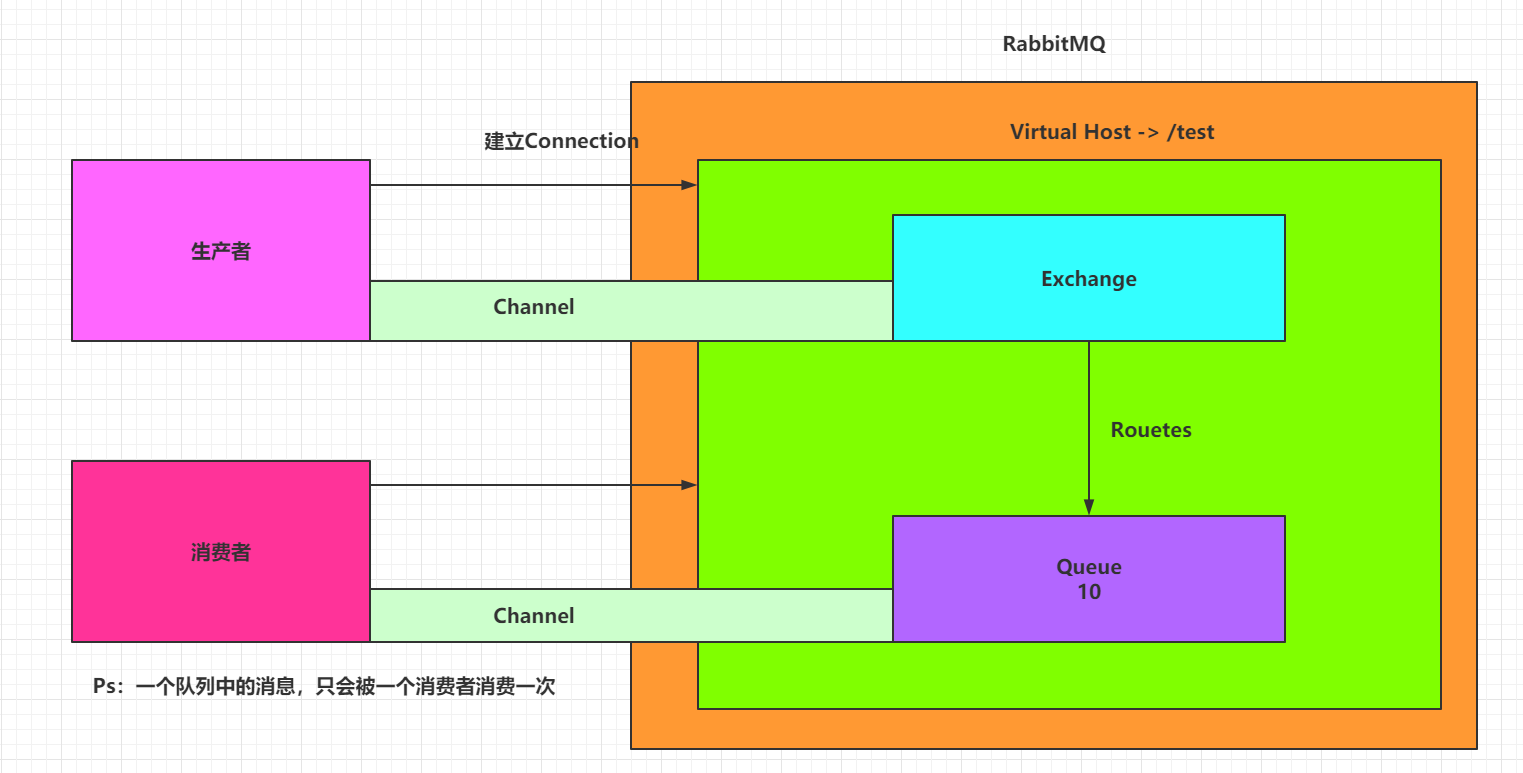
这张图中涉及到如下一些概念:
- 生产者(Publisher):发布消息到 RabbitMQ 中的交换机(Exchange)上。
- 交换机(Exchange):和生产者建立连接并接收生产者的消息。
- 消费者(Consumer):监听 RabbitMQ 中的 Queue 中的消息。
- 队列(Queue):Exchange 将消息分发到指定的 Queue,Queue 和消费者进行交互。
- 路由(Routes):交换机转发消息到队列的规则。
2. 准备工作
大家知道,RabbitMQ 是 AMQP 阵营里的产品,Spring Boot 为 AMQP 提供了自动化配置依赖 spring-boot-starter-amqp,因此首先创建 Spring Boot 项目并添加该依赖,如下:
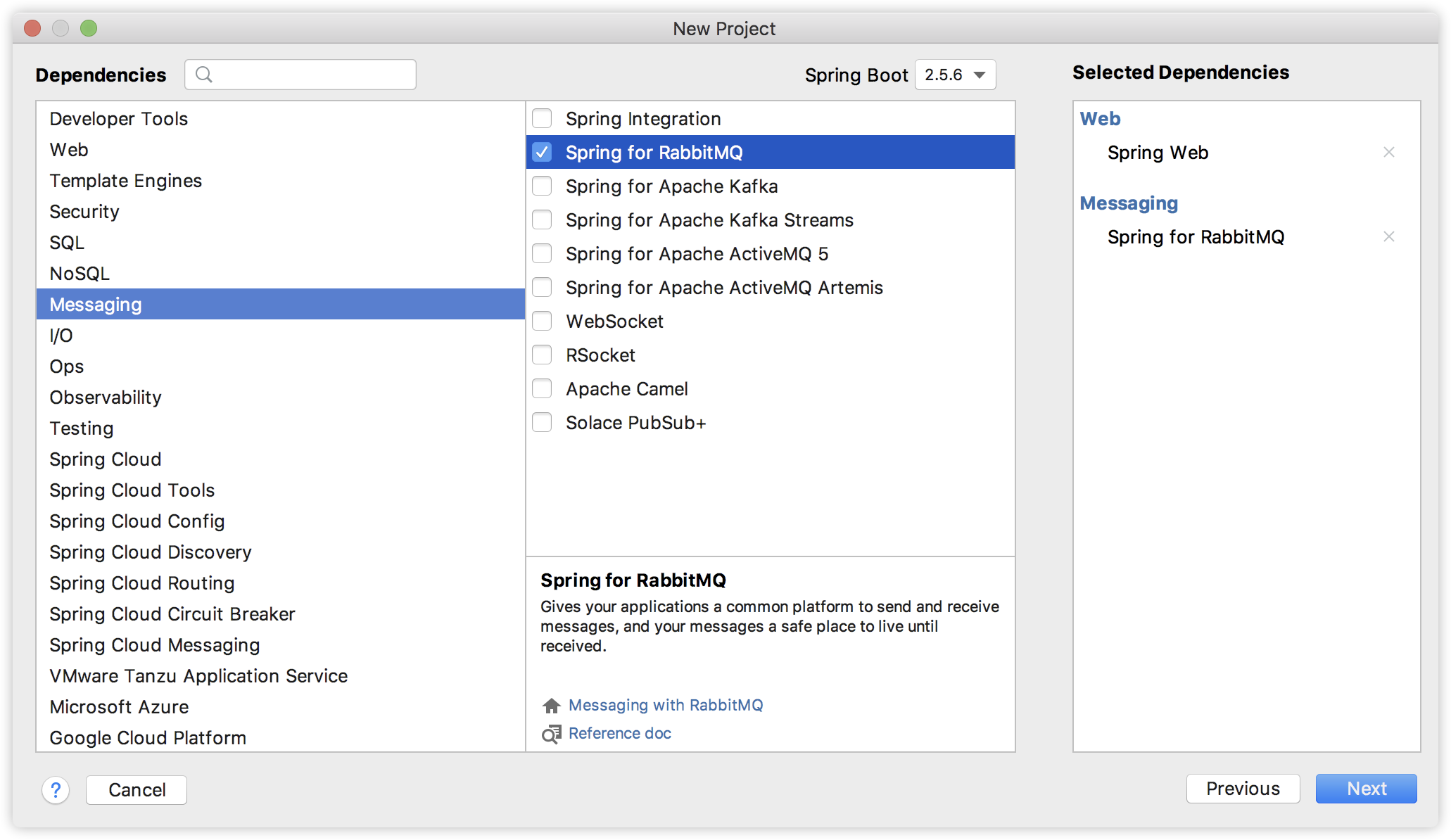
项目创建成功后,在 application.properties 中配置 RabbitMQ 的基本连接信息,如下:
1
2
3
4
| spring.rabbitmq.host=localhost
spring.rabbitmq.username=guest
spring.rabbitmq.password=guest
spring.rabbitmq.port=5672
|
接下来进行 RabbitMQ 配置,在 RabbitMQ 中,所有的消息生产者提交的消息都会交由 Exchange 进行再分配,Exchange 会根据不同的策略将消息分发到不同的 Queue 中。
RabbitMQ 官网介绍了如下几种消息分发的形式:
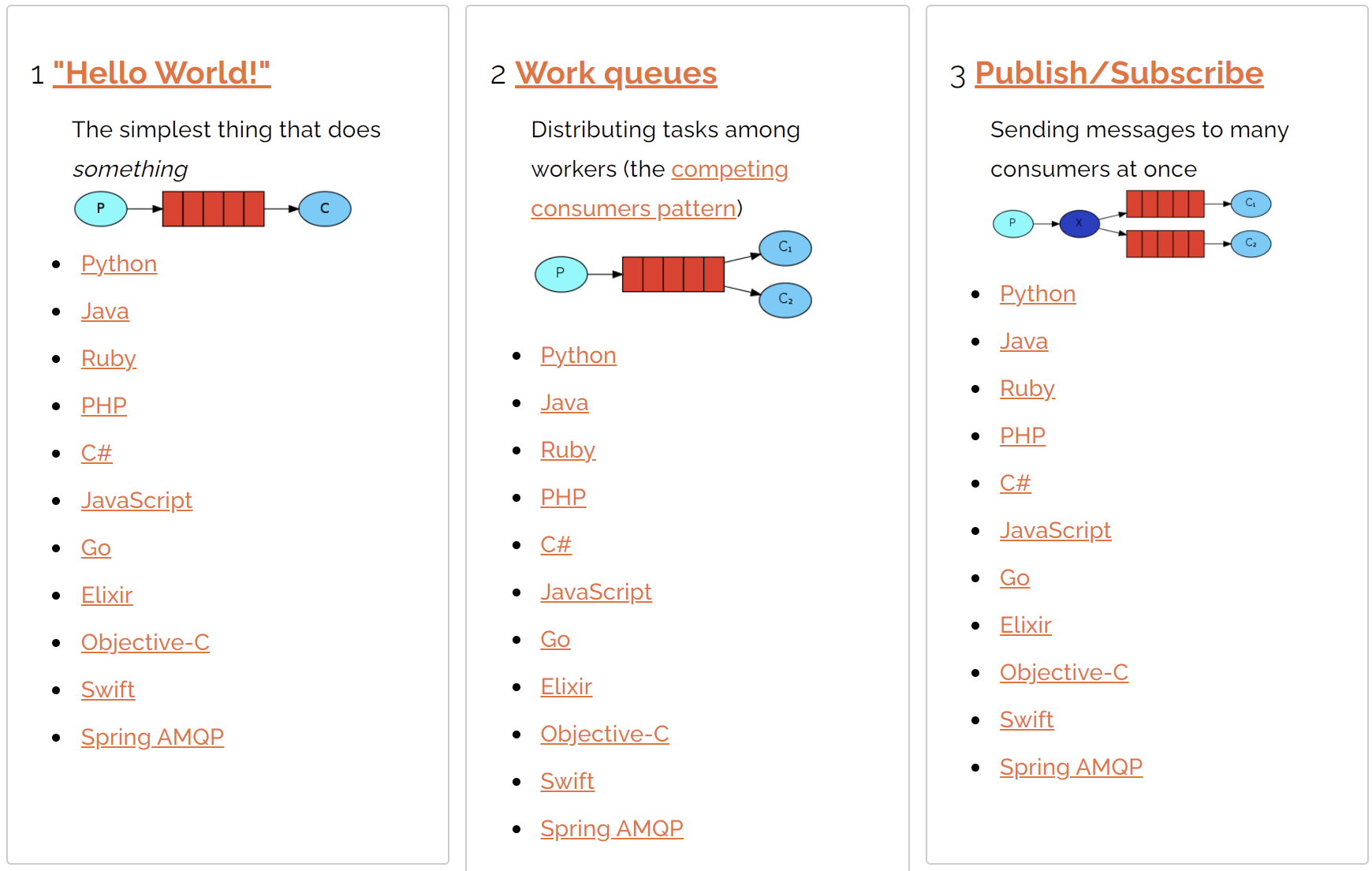
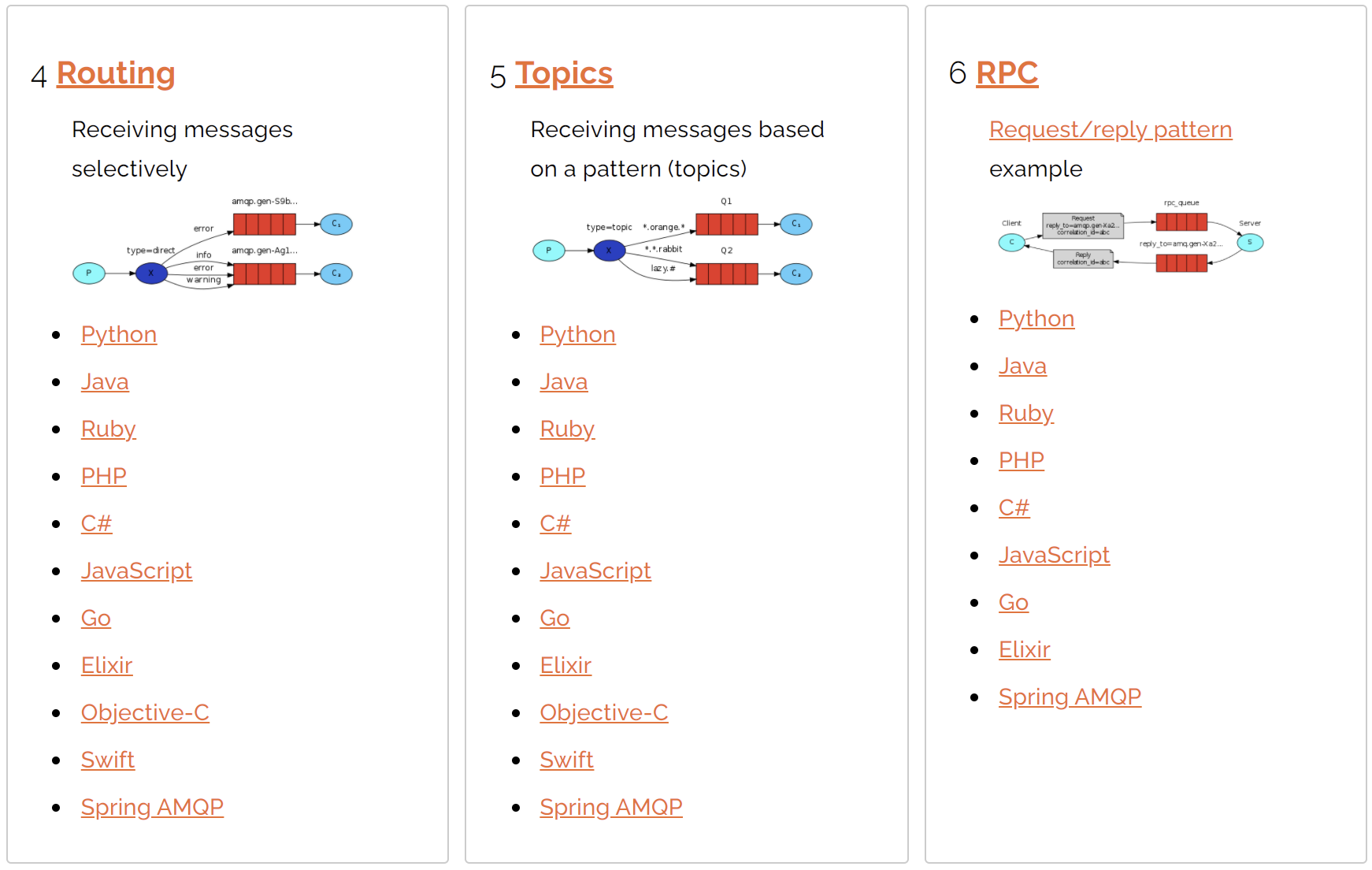

这里给出了七种,其中第七种是消息确认,消息确认这块松哥之前发过相关的文章,传送门:
所以这里我主要和大家介绍前六种消息收发方式。
3. 消息收发
3.1 Hello World
咦?这个咋没有交换机?这个其实是默认的交换机,我们需要提供一个生产者一个队列以及一个消费者。消息传播图如下:

来看看代码实现:
先来看看队列的定义:
1
2
3
4
5
6
7
8
9
10
| @Configuration
public class HelloWorldConfig {
public static final String HELLO_WORLD_QUEUE_NAME = "hello_world_queue";
@Bean
Queue queue1() {
return new Queue(HELLO_WORLD_QUEUE_NAME);
}
}
|
再来看看消息消费者的定义:
1
2
3
4
5
6
7
| @Component
public class HelloWorldConsumer {
@RabbitListener(queues = HelloWorldConfig.HELLO_WORLD_QUEUE_NAME)
public void receive(String msg) {
System.out.println("msg = " + msg);
}
}
|
消息发送:
1
2
3
4
5
6
7
8
9
10
11
12
13
| @SpringBootTest
class RabbitmqdemoApplicationTests {
@Autowired
RabbitTemplate rabbitTemplate;
@Test
void contextLoads() {
rabbitTemplate.convertAndSend(HelloWorldConfig.HELLO_WORLD_QUEUE_NAME, "hello");
}
}
|
这个时候使用的其实是默认的直连交换机(DirectExchange),DirectExchange 的路由策略是将消息队列绑定到一个 DirectExchange 上,当一条消息到达 DirectExchange 时会被转发到与该条消息 routing key 相同的 Queue 上,例如消息队列名为 “hello-queue”,则 routingkey 为 “hello-queue” 的消息会被该消息队列接收。
3.2 Work queues
这种情况是这样的:
一个生产者,一个默认的交换机(DirectExchange),一个队列,两个消费者,如下图:
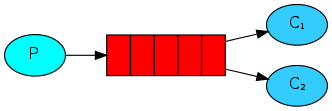
一个队列对应了多个消费者,默认情况下,由队列对消息进行平均分配,消息会被分到不同的消费者手中。消费者可以配置各自的并发能力,进而提高消息的消费能力,也可以配置手动 ack,来决定是否要消费某一条消息。
先来看并发能力的配置,如下:
1
2
3
4
5
6
7
8
9
10
11
| @Component
public class HelloWorldConsumer {
@RabbitListener(queues = HelloWorldConfig.HELLO_WORLD_QUEUE_NAME)
public void receive(String msg) {
System.out.println("receive = " + msg);
}
@RabbitListener(queues = HelloWorldConfig.HELLO_WORLD_QUEUE_NAME,concurrency = "10")
public void receive2(String msg) {
System.out.println("receive2 = " + msg+"------->"+Thread.currentThread().getName());
}
}
|
可以看到,第二个消费者我配置了 concurrency 为 10,此时,对于第二个消费者,将会同时存在 10 个子线程去消费消息。
启动项目,在 RabbitMQ 后台也可以看到一共有 11 个消费者。

此时,如果生产者发送 10 条消息,就会一下都被消费掉。
消息发送方式如下:
1
2
3
4
5
6
7
8
9
10
11
12
13
14
15
| @SpringBootTest
class RabbitmqdemoApplicationTests {
@Autowired
RabbitTemplate rabbitTemplate;
@Test
void contextLoads() {
for (int i = 0; i < 10; i++) {
rabbitTemplate.convertAndSend(HelloWorldConfig.HELLO_WORLD_QUEUE_NAME, "hello");
}
}
}
|
消息消费日志如下:

可以看到,消息都被第一个消费者消费了。但是小伙伴们需要注意,事情并不总是这样(多试几次就可以看到差异),消息也有可能被第一个消费者消费(只是由于第二个消费者有十个线程一起开动,所以第二个消费者消费的消息占比更大)。
当然消息消费者也可以开启手动 ack,这样可以自行决定是否消费 RabbitMQ 发来的消息,配置手动 ack 的方式如下:
1
| spring.rabbitmq.listener.simple.acknowledge-mode=manual
|
消费代码如下:
1
2
3
4
5
6
7
8
9
10
11
12
13
14
| @Component
public class HelloWorldConsumer {
@RabbitListener(queues = HelloWorldConfig.HELLO_WORLD_QUEUE_NAME)
public void receive(Message message,Channel channel) throws IOException {
System.out.println("receive="+message.getPayload());
channel.basicAck(((Long) message.getHeaders().get(AmqpHeaders.DELIVERY_TAG)),true);
}
@RabbitListener(queues = HelloWorldConfig.HELLO_WORLD_QUEUE_NAME, concurrency = "10")
public void receive2(Message message, Channel channel) throws IOException {
System.out.println("receive2 = " + message.getPayload() + "------->" + Thread.currentThread().getName());
channel.basicReject(((Long) message.getHeaders().get(AmqpHeaders.DELIVERY_TAG)), true);
}
}
|
此时第二个消费者拒绝了所有消息,第一个消费者消费了所有消息。
这就是 Work queues 这种情况。
3.3 Publish/Subscribe
再来看发布订阅模式,这种情况是这样:
一个生产者,多个消费者,每一个消费者都有自己的一个队列,生产者没有将消息直接发送到队列,而是发送到了交换机,每个队列绑定交换机,生产者发送的消息经过交换机,到达队列,实现一个消息被多个消费者获取的目的。需要注意的是,如果将消息发送到一个没有队列绑定的 Exchange上面,那么该消息将会丢失,这是因为在 RabbitMQ 中 Exchange 不具备存储消息的能力,只有队列具备存储消息的能力,如下图:
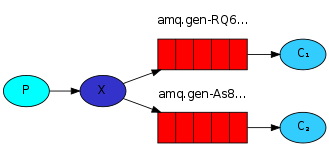
这种情况下,我们有四种交换机可供选择,分别是:
- Direct
- Fanout
- Topic
- Header
我分别来给大家举一个简单例子看下。
3.3.1 Direct
DirectExchange 的路由策略是将消息队列绑定到一个 DirectExchange 上,当一条消息到达 DirectExchange 时会被转发到与该条消息 routing key 相同的 Queue 上,例如消息队列名为 “hello-queue”,则 routingkey 为 “hello-queue” 的消息会被该消息队列接收。DirectExchange 的配置如下:
1
2
3
4
5
6
7
8
9
10
11
12
13
14
15
16
17
| @Configuration
public class RabbitDirectConfig {
public final static String DIRECTNAME = "javaboy-direct";
@Bean
Queue queue() {
return new Queue("hello-queue");
}
@Bean
DirectExchange directExchange() {
return new DirectExchange(DIRECTNAME, true, false);
}
@Bean
Binding binding() {
return BindingBuilder.bind(queue())
.to(directExchange()).with("direct");
}
}
|
- 首先提供一个消息队列Queue,然后创建一个DirectExchange对象,三个参数分别是名字,重启后是否依然有效以及长期未用时是否删除。
- 创建一个Binding对象将Exchange和Queue绑定在一起。
- DirectExchange和Binding两个Bean的配置可以省略掉,即如果使用DirectExchange,可以只配置一个Queue的实例即可。
再来看看消费者:
1
2
3
4
5
6
7
| @Component
public class DirectReceiver {
@RabbitListener(queues = "hello-queue")
public void handler1(String msg) {
System.out.println("DirectReceiver:" + msg);
}
}
|
通过 @RabbitListener 注解指定一个方法是一个消息消费方法,方法参数就是所接收到的消息。然后在单元测试类中注入一个 RabbitTemplate 对象来进行消息发送,如下:
1
2
3
4
5
6
7
8
9
10
| @RunWith(SpringRunner.class)
@SpringBootTest
public class RabbitmqApplicationTests {
@Autowired
RabbitTemplate rabbitTemplate;
@Test
public void directTest() {
rabbitTemplate.convertAndSend("hello-queue", "hello direct!");
}
}
|
最终执行结果如下:

3.3.2 Fanout
FanoutExchange 的数据交换策略是把所有到达 FanoutExchange 的消息转发给所有与它绑定的 Queue 上,在这种策略中,routingkey 将不起任何作用,FanoutExchange 配置方式如下:
1
2
3
4
5
6
7
8
9
10
11
12
13
14
15
16
17
18
19
20
21
22
23
24
| @Configuration
public class RabbitFanoutConfig {
public final static String FANOUTNAME = "sang-fanout";
@Bean
FanoutExchange fanoutExchange() {
return new FanoutExchange(FANOUTNAME, true, false);
}
@Bean
Queue queueOne() {
return new Queue("queue-one");
}
@Bean
Queue queueTwo() {
return new Queue("queue-two");
}
@Bean
Binding bindingOne() {
return BindingBuilder.bind(queueOne()).to(fanoutExchange());
}
@Bean
Binding bindingTwo() {
return BindingBuilder.bind(queueTwo()).to(fanoutExchange());
}
}
|
在这里首先创建 FanoutExchange,参数含义与创建 DirectExchange 参数含义一致,然后创建两个 Queue,再将这两个 Queue 都绑定到 FanoutExchange 上。接下来创建两个消费者,如下:
1
2
3
4
5
6
7
8
9
10
11
| @Component
public class FanoutReceiver {
@RabbitListener(queues = "queue-one")
public void handler1(String message) {
System.out.println("FanoutReceiver:handler1:" + message);
}
@RabbitListener(queues = "queue-two")
public void handler2(String message) {
System.out.println("FanoutReceiver:handler2:" + message);
}
}
|
两个消费者分别消费两个消息队列中的消息,然后在单元测试中发送消息,如下:
1
2
3
4
5
6
7
8
9
10
11
12
| @RunWith(SpringRunner.class)
@SpringBootTest
public class RabbitmqApplicationTests {
@Autowired
RabbitTemplate rabbitTemplate;
@Test
public void fanoutTest() {
rabbitTemplate
.convertAndSend(RabbitFanoutConfig.FANOUTNAME,
null, "hello fanout!");
}
}
|
注意这里发送消息时不需要 routingkey,指定 exchange 即可,routingkey 可以直接传一个 null。
最终执行日志如下:

3.3.3 Topic
TopicExchange 是比较复杂但是也比较灵活的一种路由策略,在 TopicExchange 中,Queue 通过 routingkey 绑定到 TopicExchange 上,当消息到达 TopicExchange 后,TopicExchange 根据消息的 routingkey 将消息路由到一个或者多个 Queue 上。TopicExchange 配置如下:
1
2
3
4
5
6
7
8
9
10
11
12
13
14
15
16
17
18
19
20
21
22
23
24
25
26
27
28
29
30
31
32
33
34
35
| @Configuration
public class RabbitTopicConfig {
public final static String TOPICNAME = "sang-topic";
@Bean
TopicExchange topicExchange() {
return new TopicExchange(TOPICNAME, true, false);
}
@Bean
Queue xiaomi() {
return new Queue("xiaomi");
}
@Bean
Queue huawei() {
return new Queue("huawei");
}
@Bean
Queue phone() {
return new Queue("phone");
}
@Bean
Binding xiaomiBinding() {
return BindingBuilder.bind(xiaomi()).to(topicExchange())
.with("xiaomi.#");
}
@Bean
Binding huaweiBinding() {
return BindingBuilder.bind(huawei()).to(topicExchange())
.with("huawei.#");
}
@Bean
Binding phoneBinding() {
return BindingBuilder.bind(phone()).to(topicExchange())
.with("#.phone.#");
}
}
|
- 首先创建 TopicExchange,参数和前面的一致。然后创建三个 Queue,第一个 Queue 用来存储和 “xiaomi” 有关的消息,第二个 Queue 用来存储和 “huawei” 有关的消息,第三个 Queue 用来存储和 “phone” 有关的消息。
- 将三个 Queue 分别绑定到 TopicExchange 上,第一个 Binding 中的 “xiaomi.#” 表示消息的 routingkey 凡是以 “xiaomi” 开头的,都将被路由到名称为 “xiaomi” 的 Queue 上,第二个 Binding 中的 “huawei.#” 表示消息的 routingkey 凡是以 “huawei” 开头的,都将被路由到名称为 “huawei” 的 Queue 上,第三个 Binding 中的 “#.phone.#” 则表示消息的 routingkey 中凡是包含 “phone” 的,都将被路由到名称为 “phone” 的 Queue 上。
接下来针对三个 Queue 创建三个消费者,如下:
1
2
3
4
5
6
7
8
9
10
11
12
13
14
15
| @Component
public class TopicReceiver {
@RabbitListener(queues = "phone")
public void handler1(String message) {
System.out.println("PhoneReceiver:" + message);
}
@RabbitListener(queues = "xiaomi")
public void handler2(String message) {
System.out.println("XiaoMiReceiver:"+message);
}
@RabbitListener(queues = "huawei")
public void handler3(String message) {
System.out.println("HuaWeiReceiver:"+message);
}
}
|
然后在单元测试中进行消息的发送,如下:
1
2
3
4
5
6
7
8
9
10
11
12
13
14
15
16
17
18
19
| @RunWith(SpringRunner.class)
@SpringBootTest
public class RabbitmqApplicationTests {
@Autowired
RabbitTemplate rabbitTemplate;
@Test
public void topicTest() {
rabbitTemplate.convertAndSend(RabbitTopicConfig.TOPICNAME,
"xiaomi.news","小米新闻..");
rabbitTemplate.convertAndSend(RabbitTopicConfig.TOPICNAME,
"huawei.news","华为新闻..");
rabbitTemplate.convertAndSend(RabbitTopicConfig.TOPICNAME,
"xiaomi.phone","小米手机..");
rabbitTemplate.convertAndSend(RabbitTopicConfig.TOPICNAME,
"huawei.phone","华为手机..");
rabbitTemplate.convertAndSend(RabbitTopicConfig.TOPICNAME,
"phone.news","手机新闻..");
}
}
|
根据 RabbitTopicConfig 中的配置,第一条消息将被路由到名称为 “xiaomi” 的 Queue 上,第二条消息将被路由到名为 “huawei” 的 Queue 上,第三条消息将被路由到名为 “xiaomi” 以及名为 “phone” 的 Queue 上,第四条消息将被路由到名为 “huawei” 以及名为 “phone” 的 Queue 上,最后一条消息则将被路由到名为 “phone” 的 Queue 上。
HeadersExchange 是一种使用较少的路由策略,HeadersExchange 会根据消息的 Header 将消息路由到不同的 Queue 上,这种策略也和 routingkey无关,配置如下:
1
2
3
4
5
6
7
8
9
10
11
12
13
14
15
16
17
18
19
20
21
22
23
24
25
26
27
28
| @Configuration
public class RabbitHeaderConfig {
public final static String HEADERNAME = "javaboy-header";
@Bean
HeadersExchange headersExchange() {
return new HeadersExchange(HEADERNAME, true, false);
}
@Bean
Queue queueName() {
return new Queue("name-queue");
}
@Bean
Queue queueAge() {
return new Queue("age-queue");
}
@Bean
Binding bindingName() {
Map<String, Object> map = new HashMap<>();
map.put("name", "sang");
return BindingBuilder.bind(queueName())
.to(headersExchange()).whereAny(map).match();
}
@Bean
Binding bindingAge() {
return BindingBuilder.bind(queueAge())
.to(headersExchange()).where("age").exists();
}
}
|
这里的配置大部分和前面介绍的一样,差别主要体现的 Binding 的配置上,第一个 bindingName 方法中,whereAny 表示消息的 Header 中只要有一个 Header 匹配上 map 中的 key/value,就把该消息路由到名为 “name-queue” 的 Queue 上,这里也可以使用 whereAll 方法,表示消息的所有 Header 都要匹配。whereAny 和 whereAll 实际上对应了一个名为 x-match 的属性。bindingAge 中的配置则表示只要消息的 Header 中包含 age,不管 age 的值是多少,都将消息路由到名为 “age-queue” 的 Queue 上。
接下来创建两个消息消费者:
1
2
3
4
5
6
7
8
9
10
11
12
13
| @Component
public class HeaderReceiver {
@RabbitListener(queues = "name-queue")
public void handler1(byte[] msg) {
System.out.println("HeaderReceiver:name:"
+ new String(msg, 0, msg.length));
}
@RabbitListener(queues = "age-queue")
public void handler2(byte[] msg) {
System.out.println("HeaderReceiver:age:"
+ new String(msg, 0, msg.length));
}
}
|
注意这里的参数用 byte 数组接收。然后在单元测试中创建消息的发送方法,这里消息的发送也和 routingkey 无关,如下:
1
2
3
4
5
6
7
8
9
10
11
12
13
14
15
16
17
| @RunWith(SpringRunner.class)
@SpringBootTest
public class RabbitmqApplicationTests {
@Autowired
RabbitTemplate rabbitTemplate;
@Test
public void headerTest() {
Message nameMsg = MessageBuilder
.withBody("hello header! name-queue".getBytes())
.setHeader("name", "sang").build();
Message ageMsg = MessageBuilder
.withBody("hello header! age-queue".getBytes())
.setHeader("age", "99").build();
rabbitTemplate.send(RabbitHeaderConfig.HEADERNAME, null, ageMsg);
rabbitTemplate.send(RabbitHeaderConfig.HEADERNAME, null, nameMsg);
}
}
|
这里创建两条消息,两条消息具有不同的 header,不同 header 的消息将被发到不同的 Queue 中去。
最终执行效果如下:

3.4 Routing
这种情况是这样:
一个生产者,一个交换机,两个队列,两个消费者,生产者在创建 Exchange 后,根据 RoutingKey 去绑定相应的队列,并且在发送消息时,指定消息的具体 RoutingKey 即可。
如下图:
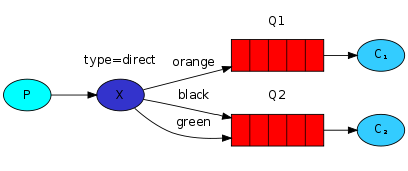
这个就是按照 routing key 去路由消息,我这里就不再举例子了,大家可以参考 3.3.1 小结。
3.5 Topics
这种情况是这样:
一个生产者,一个交换机,两个队列,两个消费者,生产者创建 Topic 的 Exchange 并且绑定到队列中,这次绑定可以通过 * 和 # 关键字,对指定 RoutingKey 内容,编写时注意格式 xxx.xxx.xxx 去编写。
如下图:

这个我也就不举例啦,前面 3.3.3 小节已经举过例子了,不再赘述。
3.6 RPC
RPC 这种消息收发形式,松哥前两天刚刚写了文章和大家介绍,这里就不多说了,传送门:
3.7 Publisher Confirms
这种发送确认松哥之前有写过相关文章,传送门:
4. 小结
好啦,今天这篇文章主要是和小伙伴们整理了 RabbitMQ 中消息收发的七种形式,感兴趣的小伙伴可以试试哦~
公众号【江南一点雨】后台回复 rabbitmqdemo,获取本文案例地址~















